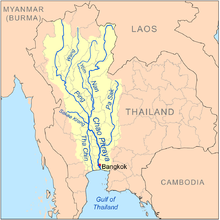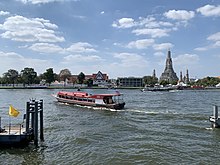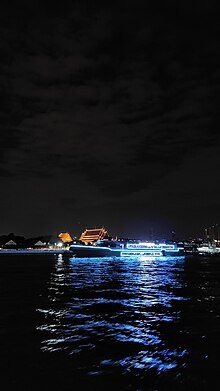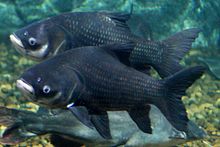Chao Phraya River
| Chao Phraya | |
|---|---|
 The Chao Phraya in Bangkok | |
 Map of the Chao Phraya River drainage basin | |
| Native name | แม่น้ำเจ้าพระยา (Thai) |
| Location | |
| Country | Thailand |
| City | Bangkok |
| Physical characteristics | |
| Source | Ping River |
| • location | Doi Thuai, Chiang Mai |
| • coordinates | 19°48′45″N 98°50′20″E / 19.81250°N 98.83889°E[1] |
| • elevation | 1,700 m (5,600 ft) |
| 2nd source | Nan Province |
| • coordinates | 19°20′0″N 101°12′0″E / 19.33333°N 101.20000°E |
| • elevation | 1,240 m (4,070 ft) |
| Source confluence | |
| • location | Nakhon Sawan |
| • coordinates | 15°42′04″N 100°08′31″E / 15.701°N 100.142°E |
| • elevation | 25 m (82 ft) |
Nakhon Sawan | |
| • average | 718 m3/s (25,400 cu ft/s) |
| • maximum | 5,960 m3/s (210,000 cu ft/s) |
| Basin features | |
| Tributaries | |
| • left | Pa Sak River |
| • right | Sakae Krang River |
The Chao Phraya (/ˌtʃaʊ prəˈjɑː/[2] or /tʃaʊˈpraɪə/;[3] Thai: แม่น้ำเจ้าพระยา, RTGS: Maenam Chao Phraya, pronounced [mɛ̂ːnáːm tɕâːw pʰráʔ.jāː] ⓘ or [tɕâːw pʰrā.jāː])[4] is the major river in Thailand,[5] with its low alluvial plain forming the centre of the country. It flows through Bangkok and then into the Gulf of Thailand.
Etymology
On many old European maps, the river is named the Mae Nam (Thai:
H. Warington Smyth, who served as Director of the Department of Mines in Siam from 1891 to 1896,[6] refers to it in his book first published in 1898 as "the Mae Nam Chao Phraya".[7]
In the English-language media in Thailand, the name Chao Phraya River is often translated as river of kings.[8]
History
On the basins of Chao Phraya River rose the earliest civilizations in the south east Asia, most notably the ancient Mon kingdom and the civilization of
Geography
The Chao Phraya begins at the confluence of the Ping and Nan rivers at Nakhon Sawan (also called Pak Nam Pho) in Nakhon Sawan province. After this, it flows south for 372 kilometres (231 mi) from the central plains to Bangkok and the Gulf of Thailand. In Chai Nat, the river then splits into the main course and the Tha Chin River, which then flows parallel to the main river and exits in the Gulf of Thailand about 35 kilometres (22 mi) west of Bangkok in Samut Sakhon.
In the low alluvial plain which begins below the Chao Phraya Dam, there are many small canals (khlong) which split off from the main river. The khlongs are used for the irrigation of the region's rice paddies.
The rough coordinates of the river are 13 N, 100 E. This area has a wet monsoon climate, with over 1,400 millimetres (55 in) of rainfall per year. Temperatures range from 24 to 33 °C (75 to 91 °F) in Bangkok.
River engineering
The lower Chao Phraya underwent several human-made modifications during the Ayutthaya period. Several shortcut canals were constructed to bypass large loops in the river, shortening the trip from the capital city to the sea. The course of the river has since changed to follow many of these canals.
- In 1538, Thailand's first Ayutthaya.[9]
- In 1542, a two kilometer-long canal, "Khlong Lat Bangkok", was completed. The Chao Phraya then diverted along the new canal, its old course becoming part of Khlong Bangkok Noi and Khlong Bangkok Yai. It is said to have shortened the river route by 14 km (9 mi).[9]
- In 1608, a seven kilometer-long "Khlong Bang Phrao" canal was completed and has shortened the Chao Phraya's original route by 18 km (11 mi).[9]
- In 1636, the "Khlong Lat Mueang Nonthaburi" was completed.[9]
- In 1722, the two kilometre long "Khlong Lat Kret Noi" shortened the Chao Phraya by 7 km (4 mi). This route formed the island of Ko Kret.[9]
River settlements
Cities along the Chao Phraya include, from north to south,
Transportation

Major bridges cross the Chao Phraya in Bangkok: the
In Bangkok, the Chao Phraya is a major transportation artery for a network of river buses, cross-river ferries, and water taxis ("longtails"). More than 15 boat lines operate on the rivers and canals of the city, including
Tourism
The Chao Phraya River has a significant impact on tourism in Bangkok. The various attractions along the riverbanks, such as cruises, cafes, malls, etc., are highly popular among tourists.

Tributaries
The principal tributaries of the Chao Phraya River are the
Length

When measured from the most commonly accepted source, which is the confluence of the Ping and Nan River in Nakhon Sawan, the river measures 372 km (231 mi). However, when measured from the longest source, which is the origin point of the Nan River in the Luang Prabang Range, the river measures 1,112 km (691 mi).
Chao Phraya watershed

The expanse of the Chao Phraya River and its tributaries, i.e., the Chao Phraya river system, together with the land upon which falling rain drains into these bodies of water, form the Chao Phraya watershed.[14]
The Chao Phraya watershed is the largest watershed in Thailand, covering approximately 35 percent of the nation's land, and draining an area of 157,924 square kilometres (60,975 sq mi).[15]
The watershed is divided into the following basins:
- Pa Sak Basin
- Sakae Krang Basin
- Greater Nan Basin (composed of the Nan Basin and the Yom Basin, and usually divided as such in drainage analyses)
- Greater Ping Basin (composed of the Ping Basin and the Wang Basin, and usually divided as such in drainage analyses)
- Tha Chin Basin (the basin of the Chao Phraya's most significant distributaries)
- Finally the Chao Phraya Basin itself is defined as the portion of the Chao Phraya watershed drained by the Chao Phraya River itself, and not by its major tributaries or distributaries. As such, the Chao Phraya Basin drains 20,126 square kilometres (7,771 sq mi) of land.[15]
To the west, the central plain of Thailand is drained by the Mae Klong and the east by the Bang Pakong River. They are not part of the Chao Praya system.
The landscape of the river basins is a very wide, flat, well-watered plain continuously refreshed with soil and sediment brought down by the rivers. The lower central plain from the delta north to
Delta

The Tha Chin River is the major distributary of the Chao Phraya River. The expanse of the Chao Phraya and Tha Chin Rivers and their distributaries, starting at the point at which the distributaries diverge, together with the land amid the triangle formed by the outermost and innermost distributary, form the Chao Phraya delta. The many distributaries of the Chao Phraya delta are interconnected by canals that serve both for irrigation and for transportation.
Ecology
The lowland areas of the Chao Phraya watershed in central Thailand have been designated as the Chao Phraya freshwater swamp forests, a tropical and subtropical moist broadleaf forests ecoregion,[16] an area about 400 km (249 mi) north to south and 180 km (112 mi) wide.
The original swamp forests have almost entirely been removed as the plain has been converted to rice paddies, other agriculture, and urban areas like Bangkok. Much of the wildlife that once inhabited these plains has disappeared, including a large number of fish in the river systems, birds such as vultures, the Oriental darter (Anhinga melanogaster), white-eyed river martin (Pseudochelidon sirintarae), the sarus crane (Grus antigone)[17] and animals such as tigers, Asian elephants, Javan rhinoceroses, and the much-hunted Schomburgk's deer.[18] Today we can only guess at the original habitat and wildlife by comparing it with neighbouring countries. It is believed that the area would have consisted of freshwater swamps inland and salty mangroves on the coast and the river estuaries. The swamp would have been covered in Phragmites marsh grasses. Today there is a small area of this remaining in Khao Sam Roi Yot National Park, a relic of the original landscape.
As so much has been cleared or altered the potential for creating large protected areas to preserve original habitat no longer exists. However much wildlife does remain in the rice fields and steps may be taken to preserve these as urban and industrial development on the plains is ongoing and the Industrial Estate Authority of Thailand has very little control or planning over this. Particular threats come from the conversion of rice paddies to large-scale production of prawns by pumping in seawater, and the use of pesticides to eliminate the introduced snail,Pomacea canaliculata, which damages rice plants.
There are populations of threatened birds, including colonies of breeding water birds such as the world's largest populations of the near-threatened Asian openbill (Anastomus oscitans), and other birds such as the wintering black kite (Milvus migrans). Endemic mammals that remain are the limestone rat (Niviventer hinpoon), Neill's long-tailed giant rat (Leopoldamys neilli), and the near-endemic Thailand roundleaf bat (Hipposideros halophyllus).
The Chao Phraya basin is home to about half a dozen endemic
There are few areas of wetland protected as national parks, but these are mostly very small.
Fish

The Chao Phraya

There has been extensive habitat destruction (pollution, dams, and drainage for irrigation) in the Chao Phraya basin and overfishing also presents a problem.[19][24][25][26] Within mainland Southeast Asia, the only freshwater region with similar high levels of threat is the lower Mekong.[19] It has been estimated that only around 30 native fish species still are able to reproduce in the mainstream of the Chao Phraya River.[19]
The catfish
Many other species that either are prominent in the aquarium trade or important
Pollution
The Thai Pollution Control Department (PCD) reports that the water quality of major rivers flowing into the upper Gulf of Thailand has seriously deteriorated in the past decade.[
See also
- River Systems of Thailand
- Kapuas River
References
- ^ "Chiang Dao National Park". Thai Forest Booking. Retrieved 20 May 2009.
- ^ "Chao Phraya". Lexico UK English Dictionary. Oxford University Press.[dead link]
- ^ "Chao Phraya". Merriam-Webster.com Dictionary.
- ^ Pronunciation
- ^ ]
- ^ Tamara Loos (1 December 2002). "Introduction to Five Years in Siam". 1994 reprint. Pine Tree Web. Archived from the original on 19 December 2010. Retrieved 1 March 2011.
At the time of writing the "Introduction" to the 1994 reprint of Five Years in Siam, she was a PhD candidate in the Department of History at Cornell University.
- ISBN 974-8495-98-1. Archived from the originalon 19 December 2010. Retrieved 1 March 2011.
- ^ "The River of Kings II : City of Angels". Thai Stories. Archived from the original on 12 June 2019. Retrieved 3 March 2011.
"The River of Kings II – City of Angels", a light and sound musical
- ^ a b c d e Steve Van Beek: The Chao Phya, p.39
- ^ a b "Royal Irrigation Department River Gauges Report". RID Stations. 2002. Archived from the original on 14 August 2009. Retrieved 20 July 2008.
- ^ "Chao Phraya River Basin (Thailand)". World Water Assessment Programme. Archived from the original on 8 June 2008. Retrieved 20 July 2008.
- ^ "Detailed Map of the Chao Phraya River Basin (Thailand)". World Water Assessment Programme. Archived from the original on 18 September 2008. Retrieved 20 July 2008.
- ^ Google Earth
- ^ River and Watershed Facts on the Chao Phraya Archived 4 January 2009 at the Wayback Machine
- ^ a b Basins of Thailand[permanent dead link]
- ^ "Chao Phraya freshwater swamp forests". Terrestrial Ecoregions. World Wildlife Fund.
- ^ Madoc, G. 1950. Field Notes on some Siamese Birds. Bull. Raffles Mus. 23: 129–190.
- ^ IUCN 1991. The Conservation Atlas of Tropical Forests: Asia and the Pacific. London and Basingstoke: Macmillan Press Ltd.
- ^ ISBN 978-2-8317-1424-0.
- ^ Froese, Rainer; Pauly, Daniel (eds.) (2015). "Catlocarpio siamensis" in FishBase. March 2015 version.
- ^ . Retrieved 9 January 2018.
- ^ a b Freshwater Ecoregions of the World (2013). Chao Phraya Archived 4 March 2016 at the Wayback Machine. Retrieved 7 March 2015.
- ^ . Retrieved 13 November 2021.
- ^ Samorn Muttamara, S. & Sales, C. L. (1994). Water quality management of the Chao Phraya River (a case study). Environmental Technology 15(6).
- ^ Molle, F. (2005). Elements for a political ecology of river basins development: The case of the Chao Phraya river basin, Thailand. Paper presented to the 4th Conference of the International Water History Association, December 2005, Paris.
- ISBN 9781845936181.
- . Retrieved 9 January 2018.
- . Retrieved 9 January 2018.
- doi:10.2305/IUCN.UK.2009-2.RLTS.T15945A5324983.en. Retrieved 9 January 2018.)
{{cite journal}}: CS1 maint: multiple names: authors list (link - . Retrieved 9 January 2018.
- . Retrieved 13 November 2021.
- . Retrieved 13 November 2021.
- . Retrieved 9 January 2018.
- ^ FishBase: Fish Species in Chao Phraya River. Retrieved 7 March 2015.
- ISBN 978-616-316-327-1. Archived from the original(PDF) on 5 September 2017. Retrieved 23 September 2016.
- ^ Wangkiat, Paritta (25 September 2016). "Breach of trust". Bangkok Post. Retrieved 25 September 2016.
- ^ "Plastic River: Following the Waste That's Choking the Chao Phraya". newsecuritybeat.org.
- ^ "Interceptor for Chao Phraya". theoceancleanup.com.
Further reading
- Bangkok Waterways, William Warren and R. Ian Lloyd, Asia Books, ISBN 981-00-1011-7.
External links
- Video Guide to the Chao Phraya River
- Chao Phraya River Express
- UNESCO World Water Assessment Program on the Chao Phraya
- Chao Phraya Delta Research and Reference Site
- Bangkok Chao Phraya River Boat Trip a self-guided boat trip on Bangkok's Chao Phraya river.
- Bangkok's Chao Phraya River Cruise one of the popular tourist attractions in Bangkok.


